Microfluidic Study of Enhanced Oil Recovery during Flooding with Polyacrylamide Polymer Solutions
Abstract
1. Introduction
2. Materials and Methods
2.1. Polymer Solutions
2.2. Crude Oil
2.3. Contact Angle and Interfacial Tension
2.4. Microfluidic Chip and Experimental Procedure
3. Results and Discussion
3.1. Rheology of Polymer Solutions
3.2. Wettability Characteristics
3.3. Microfluidic Oil Displacement by Polymer Solutions
4. Conclusions
Supplementary Materials
Author Contributions
Funding
Data Availability Statement
Acknowledgments
Conflicts of Interest
References
- Sheng, J.J.; Leonhardt, B.; Azri, N. Status of Polymer-Flooding Technology. J. Can. Pet. Technol. 2015, 54, 116–126. [Google Scholar] [CrossRef]
- Prasad, D.; Singh, A.K.; Shekhar, S.; Kumar, M.S.; Pandey, A. Two Decades of Mangala Field Journey—Key Highlights, Learnings and Recommendations. In Proceedings of the ADIPEC, Abu Dhabi, United Arab Emirates, 31 October–3 November 2022. [Google Scholar] [CrossRef]
- Wang, D.; Li, C.; Seright, R.S. Laboratory Evaluation of Polymer Retention in a Heavy Oil Sand for a Polymer Flooding Application on Alaska’s North Slope. SPE J. 2020, 25, 1842–1856. [Google Scholar] [CrossRef]
- Jouenne, S. Polymer Flooding in High Temperature, High Salinity Conditions: Selection of Polymer Type and Polymer Chemistry, Thermal Stability. J. Pet. Sci. Eng. 2020, 195, 107545. [Google Scholar] [CrossRef]
- Taber, J.J.; Martin, F.D.; Seright, R.S. EOR Screening Criteria Revisited— Part 1: Introduction to Screening Criteria and Enhanced Recovery Field Projects. SPE Reservoir Eng. 1997, 12, 189–198. [Google Scholar] [CrossRef]
- Seright, R.S.; Fan, T.; Wavrik, K.; Wan, H.; Gaillard, N.; Favéro, C. Rheology of a New Sulfonic Associative Polymer in Porous Media. In Proceedings of the SPE International Symposium on Oilfield Chemistry, The Woodlands, TX, USA, 11–13 April 2011. [Google Scholar] [CrossRef]
- Cancela, B.R.; Palermo, L.C.M.; de Oliveira, P.F.; Mansur, C.R.E. Rheological Study of Polymeric Fluids Based on HPAM and Fillers for Application in EOR. Fuel 2022, 330, 125647. [Google Scholar] [CrossRef]
- Wang, D.; Zhang, J.; Meng, F.; Liu, H.; Li, L.; Han, B.; Qi, L. Commercial Test of Polymer Flooding in Daqing Oil Field Daqing petroleum Administrative Bureau. In Proceedings of the International Meeting on Petroleum Engineering, Beijing, China, 14–17 November 1995. [Google Scholar] [CrossRef]
- Putz, A.G.; Rivenq, R.C. Commercial Polymer Injection in the Courtenay Field. In Proceedings of the IOR 1991—6th European Symposium on Improved Oil Recovery, Stavanger, Norway, 21–23 May 1991. [Google Scholar] [CrossRef]
- Wang, K.; You, Q.; Long, Q.-M.; Zhou, B.; Wang, P. Experimental Study of the Mechanism of Nanofluid in Enhancing the Oil Recovery in Low Permeability Reservoirs Using Microfluidics. Pet. Sci. 2023, 20, 382–395. [Google Scholar] [CrossRef]
- Fang, Z.; Cao, X.-R.; Yu, Y.-L.; Li, M. Fabrication and Characterization of Microcapsule Encapsulating EOR Surfactants by Microfluidic Technique. Colloids Surf. A 2019, 570, 282–292. [Google Scholar] [CrossRef]
- Kumar Thimmaraju, M.; Trivedi, R.; Hemalatha, G.; Thirupathy, B.; Mohathasim Billah, A. Microfluidic Revolution and its Impact on Pharmaceutical Materials: A review. Mater. Today Proc. 2023, in press. [Google Scholar] [CrossRef]
- Adampourezare, M.; Dehghan, G.; Hasanzadeh, M.; Hosseinpoure Feizi, M.-A. Application of Lateral Flow and Microfluidic Bio-Assay and Biosensing Towards Identification of DNA-Methylation and Cancer Detection: Recent Progress and Challenges in Biomedicine. Biomed. Pharmacother. 2021, 141, 111845. [Google Scholar] [CrossRef]
- Mahmoudzadeh, A.; Fatemi, M.; Masihi, M. Microfluidics Experimental Investigation of the Mechanisms of Enhanced Oil Recovery by Low Salinity Water Flooding in Fractured Porous Media. Fuel 2022, 314, 123067. [Google Scholar] [CrossRef]
- Raihan, M.K.; Jagdale, P.P.; Wu, S.; Shao, X.; Bostwick, J.B.; Pan, X.; Xuan, X. Flow of Non-Newtonian Fluids in a Single-Cavity Microchannel. Micromachines 2021, 12, 836. [Google Scholar] [CrossRef] [PubMed]
- Jagdale, P.P.; Li, D.; Shao, X.; Bostwick, J.B.; Xuan, X. Fluid Rheological Effects on the Flow of Polymer Solutions in a Contraction–Expansion Microchannel. Micromachines 2020, 11, 278. [Google Scholar] [CrossRef] [PubMed]
- Yuan, H.; Yuan, W.; Duan, S.; Jiao, K.; Zhang, Q.; Lim, E.G.; Chen, M.; Zhao, C.; Pan, P.; Liu, X.; et al. Microfluidic-Assisted Caenorhabditis Elegans Sorting: Current Status and Future Prospects. Cyborg Bionic Syst. 2023, 4, 0011. [Google Scholar] [CrossRef]
- Zhang, Y.; Cao, M.; Peng, Y.; Jin, X.; Tian, D.; Liu, K.; Jiang, L. Bioinspired Continuous and Spontaneous Antigravity Oil Collection and Transportation. Adv. Funct. Mater. 2017, 28, 1704220. [Google Scholar] [CrossRef]
- Lei, Z.; Liu, Y.; Wang, R.; Li, L.; Liu, Y.; Zhang, Y. A Microfluidic Experiment on CO2 Injection for Enhanced Oil Recovery in a Shale Oil Reservoir with High Temperature and Pressure. Energies 2022, 15, 9461. [Google Scholar] [CrossRef]
- Wang, Y.; Jiang, H.; Li, L.; Wang, L.; Li, J. Flow Physics of Profile Control Fluids in Porous Media and Implications for Enhanced Oil Recovery: A Microfluidic Study. Processes 2022, 10, 112. [Google Scholar] [CrossRef]
- Aadland, R.C.; Akarri, S.; Heggset, E.B.; Syverud, K.; Torsæter, O. A Core Flood and Microfluidics Investigation of Nanocellulose as a Chemical Additive to Water Flooding for EOR. Nanomaterials 2020, 10, 1296. [Google Scholar] [CrossRef]
- Minakov, A.V.; Rudyak, V.Y.; Pryazhnikov, M.I. Systematic Experimental Study of the Viscosity of Nanofluids. Heat Transfer. Eng. 2020, 42, 1024–1040. [Google Scholar] [CrossRef]
- Pryazhnikov, M.I.; Minakov, A.V. Bulk Viscosity of a Suspension of Silicon Oxide Nanoparticles. Tech. Phys. Lett. 2020, 46, 606–609. [Google Scholar] [CrossRef]
- Riley, B.J.; Lennard, C.; Fuller, S.; Spikmans, V. An FTIR Method for the Analysis of Crude and Heavy Fuel Oil Asphaltenes to Assist in Oil Fingerprinting. Forensic. Sci. Int. 2016, 266, 555–564. [Google Scholar] [CrossRef]
- Doyle, A.; Saavedra, A.; Tristão, M.L.B.; Aucelio, R.Q. Determination of S, Ca, Fe, Ni and V in Crude Oil by Energy Dispersive X-Ray Fluorescence Spectrometry Using Direct Sampling on Paper Substrate. Fuel 2015, 162, 39–46. [Google Scholar] [CrossRef]
- Minakov, A.V.; Pryazhnikov, M.I.; Suleymana, Y.N.; Meshkova, V.D. An Experimental Study of the Effect of the Addition of Silicon Oxide Nanoparticles on the Wettability Characteristics of Rocks with Respect to Oil. Tech. Phys. Lett. 2020, 46, 1238–1240. [Google Scholar] [CrossRef]
- Fjær, E.; Holt, R.M.; Horsrud, P.; Raaen, A.M.; Risnes, R. Geological Aspects of Petroleum Related Rock Mechanics. Pet. Relat. Rock Mech. 2021, 72, 157–200. [Google Scholar] [CrossRef]
- Pryazhnikov, M.I.; Minakov, A.V.; Pryazhnikov, A.I.; Denisov, I.A.; Yakimov, A.S. Microfluidic Study of the Effect of Nanosuspensions on Enhanced Oil Recovery. Nanomaterials 2022, 12, 520. [Google Scholar] [CrossRef]
- Cagney, N.; Lacassagne, T.; Balabani, S. Taylor–Couette Flow of Polymer Solutions with Shear-Thinning and Viscoelastic Rheology. J. Fluid Mech. 2020, 905, A28. [Google Scholar] [CrossRef]
- Ostwald, W. Ueber die rechnerische Darstellung des Strukturgebietes der Viskosit ät. Kolloid Zeitschrift. 1929, 47, 176–187. [Google Scholar] [CrossRef]
- Kung, C.H.; Sow, P.K.; Zahiri, B.; Mérida, W. Assessment and Interpretation of Surface Wettability Based on Sessile Droplet Contact Angle Measurement: Challenges and Opportunities. Adv. Mater. Interfaces 2019, 6, 1900839. [Google Scholar] [CrossRef]
- Young, T., III. An essay on the cohesion of fluids. Philos. Trans. R. Soc. Lond. 1805, 95, 65–87. [Google Scholar]
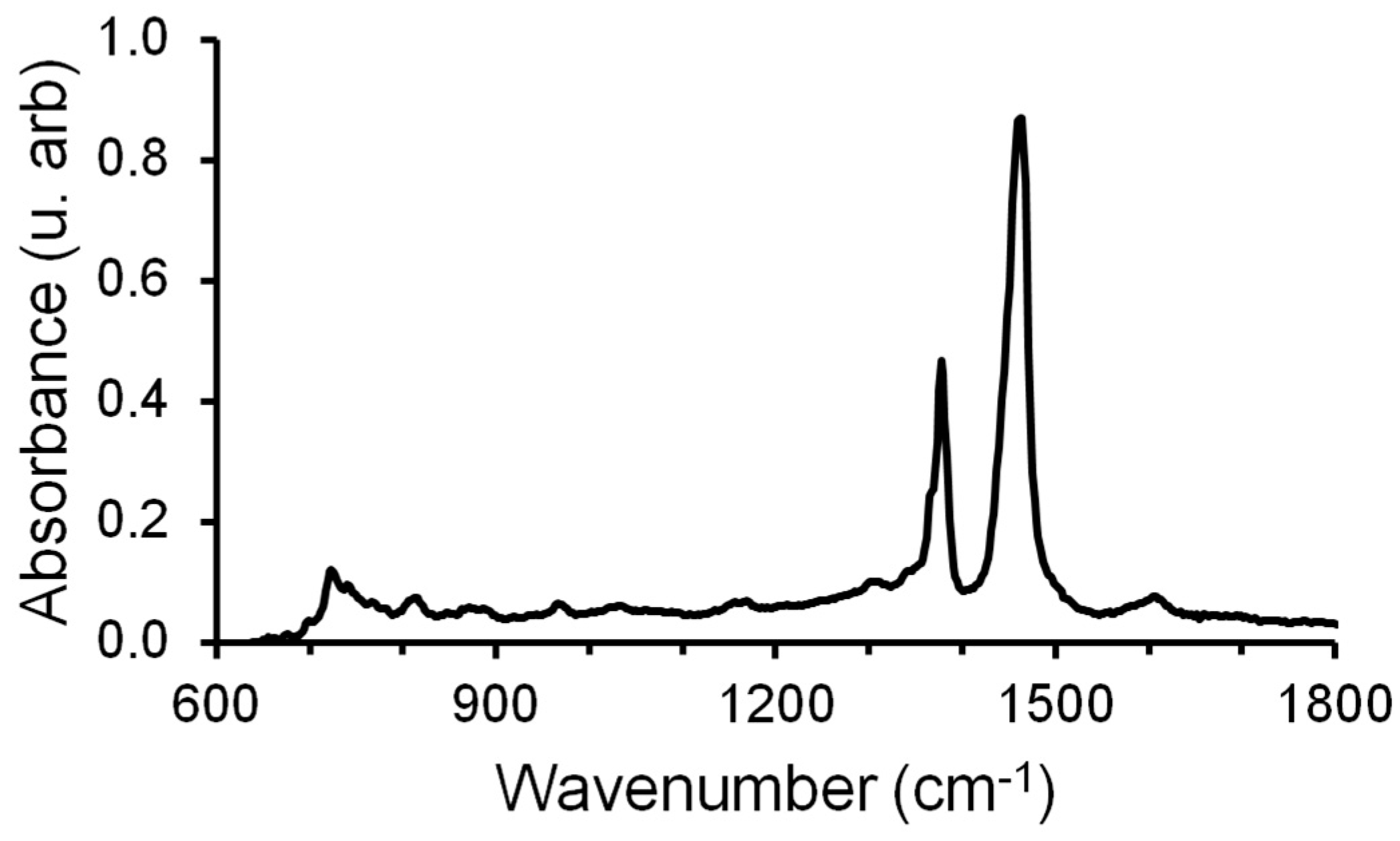



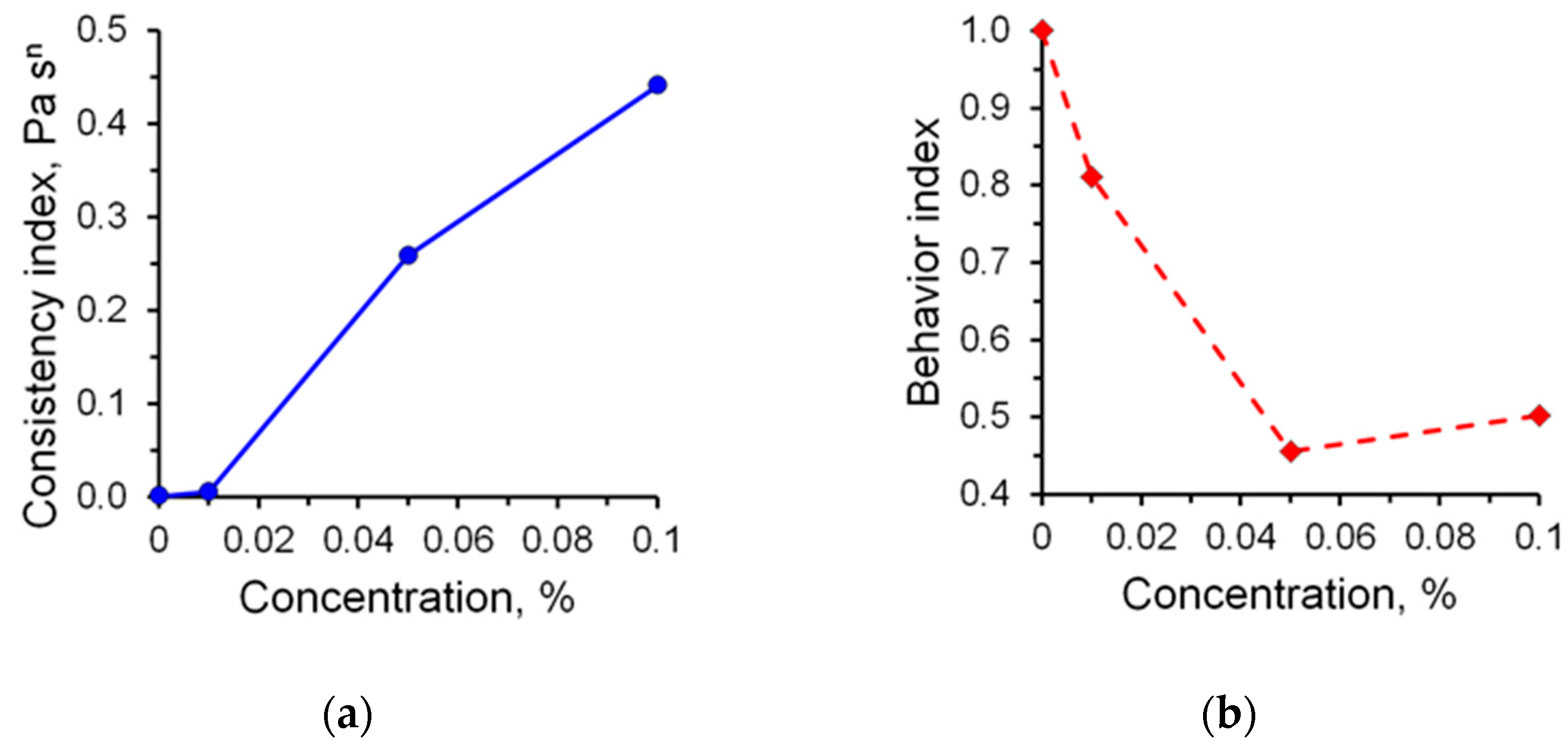


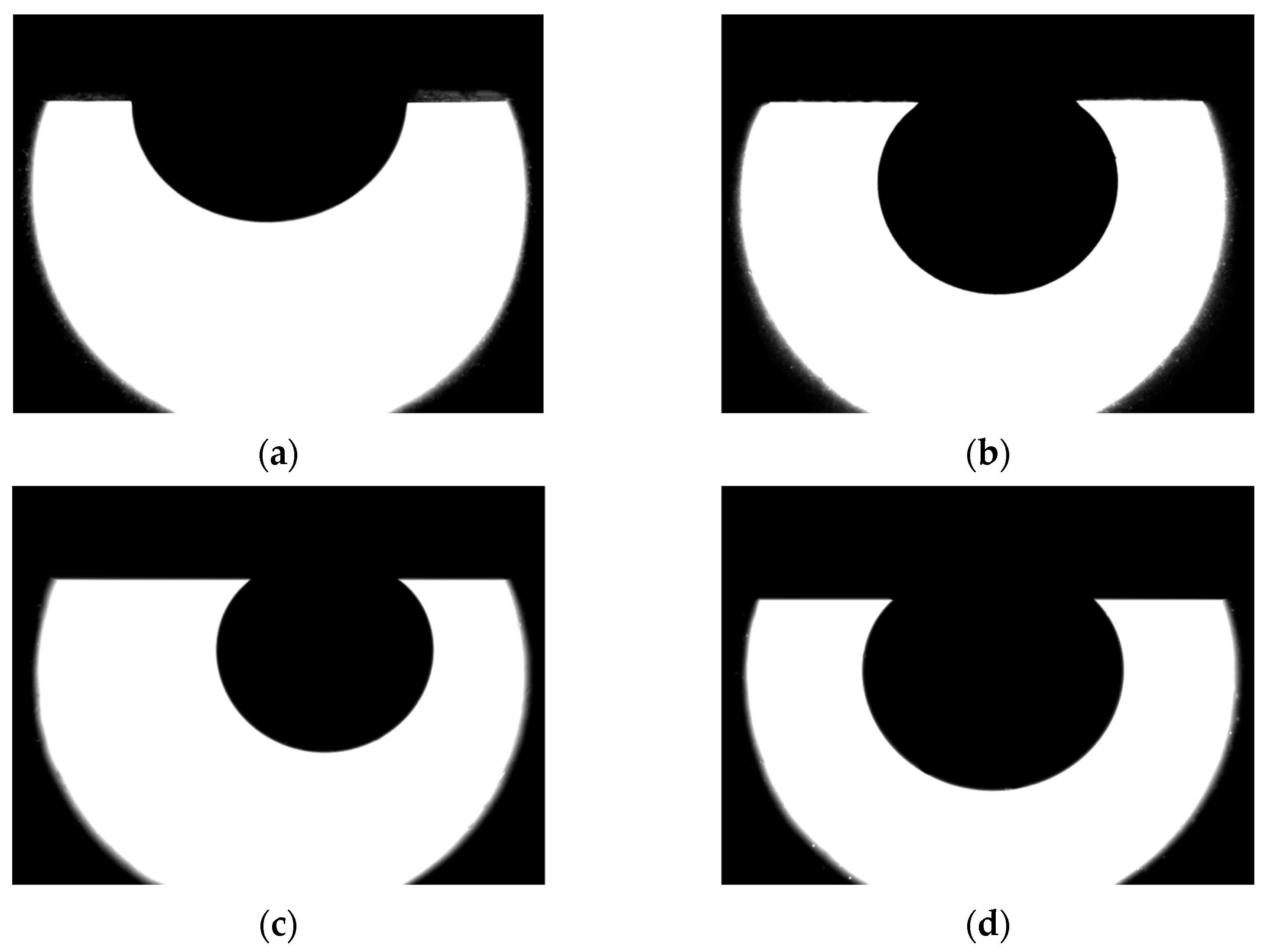
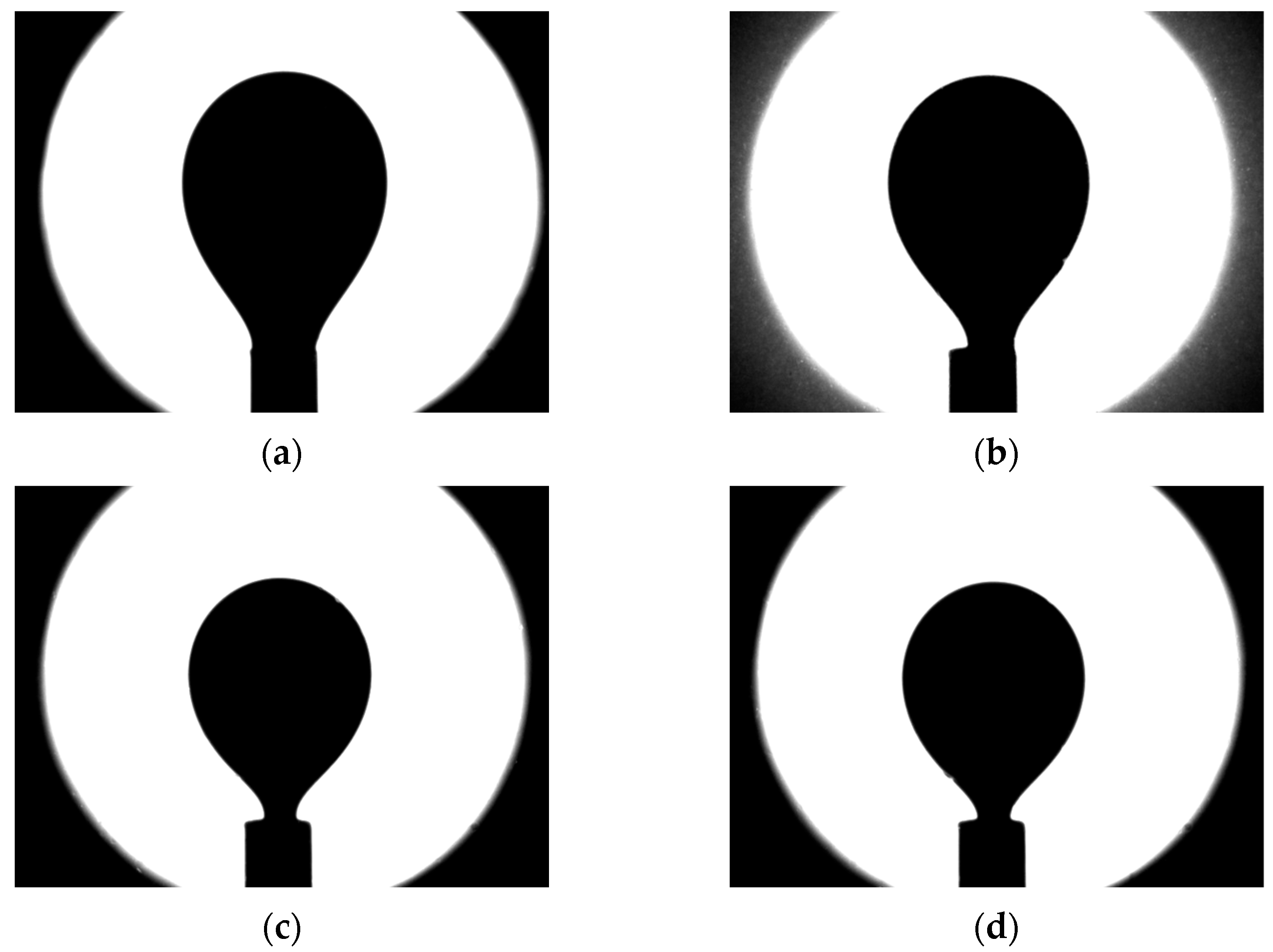

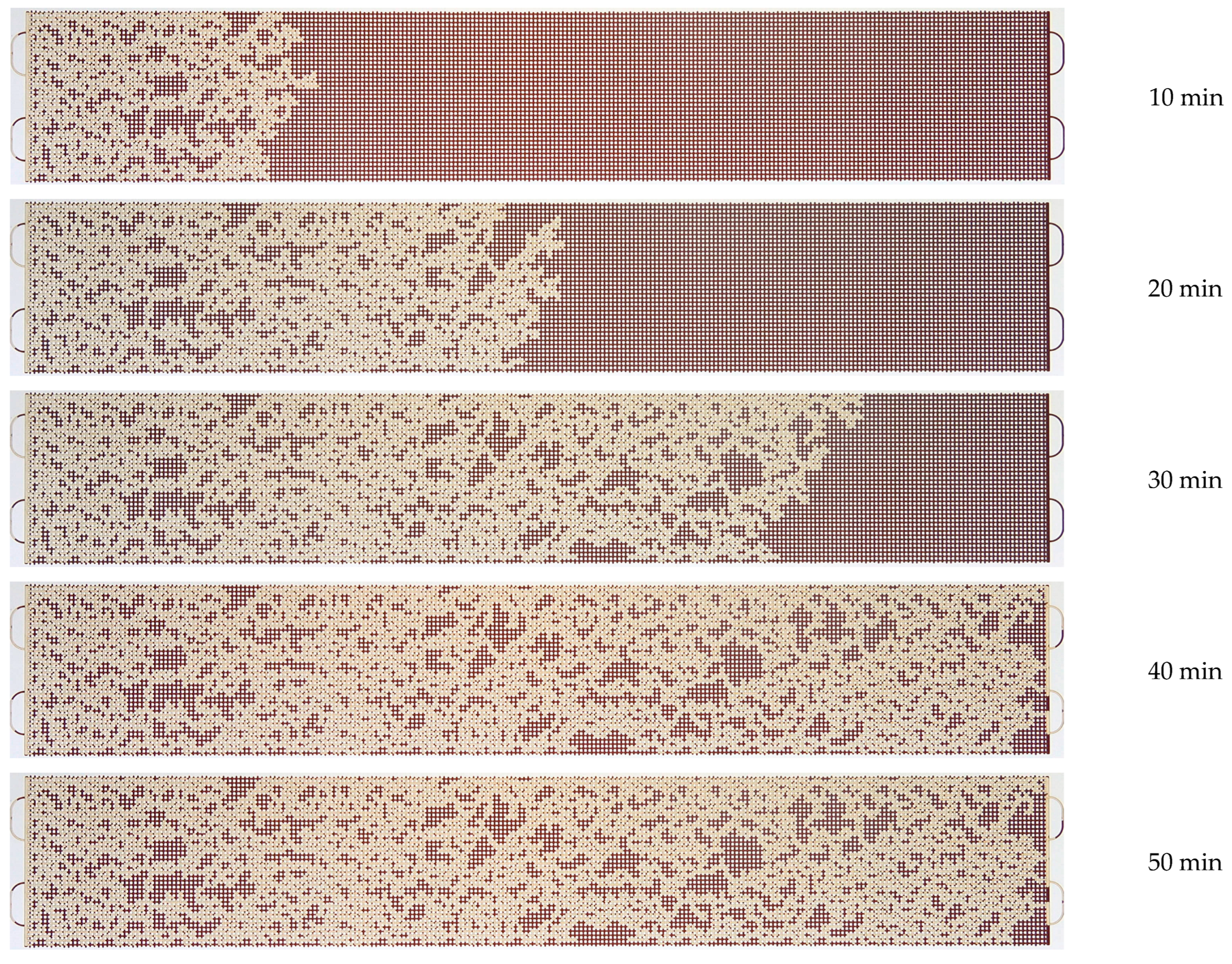


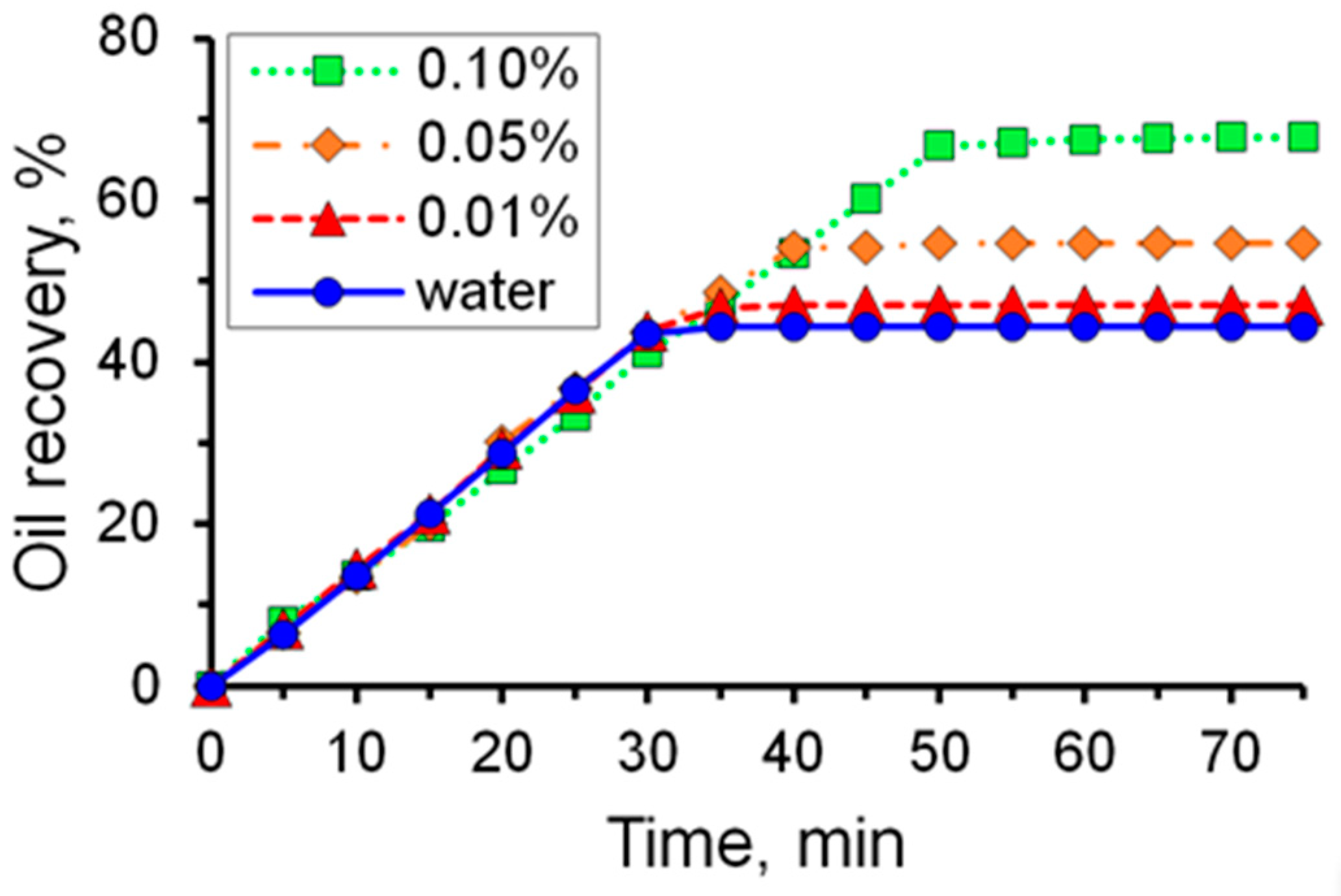
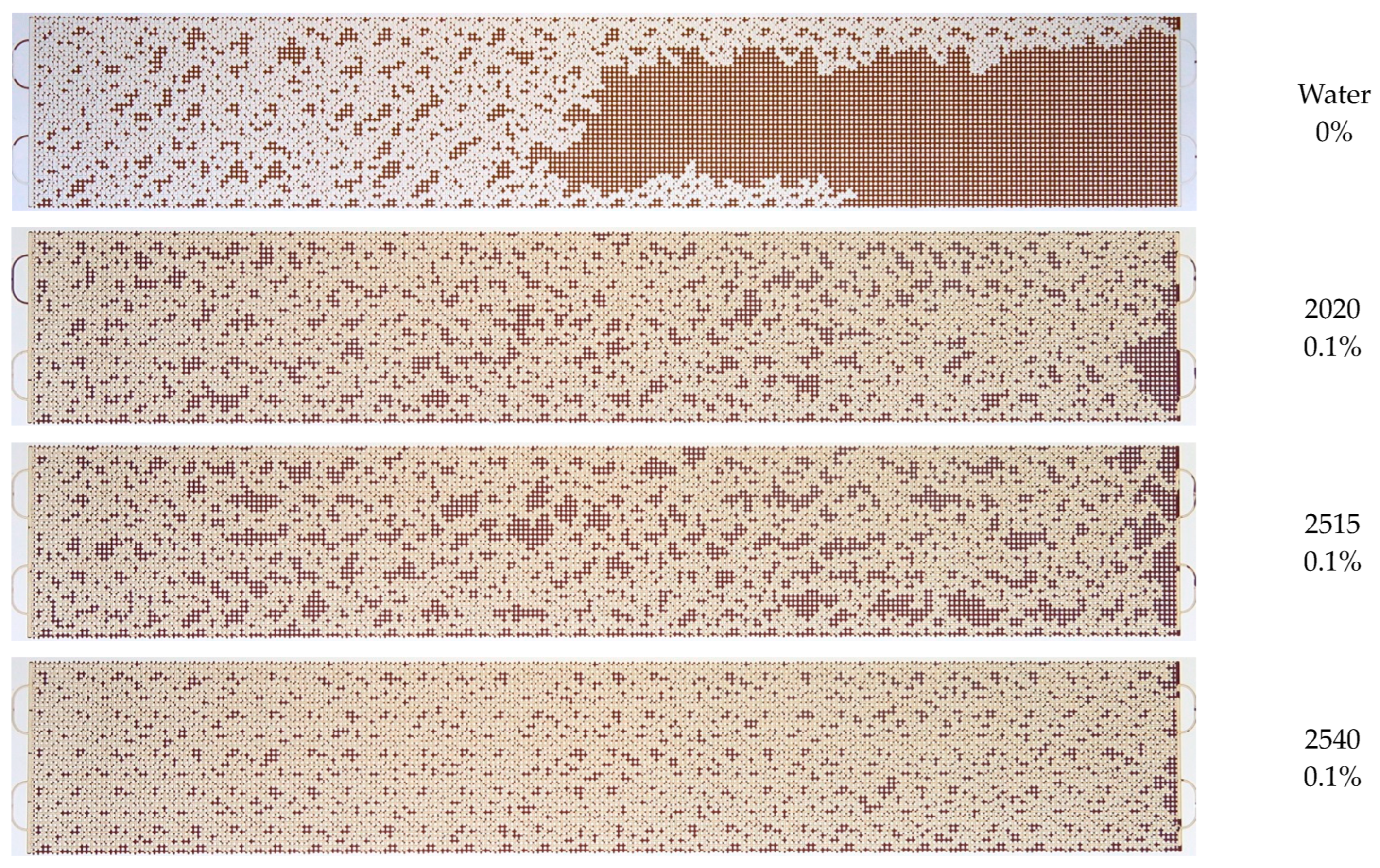
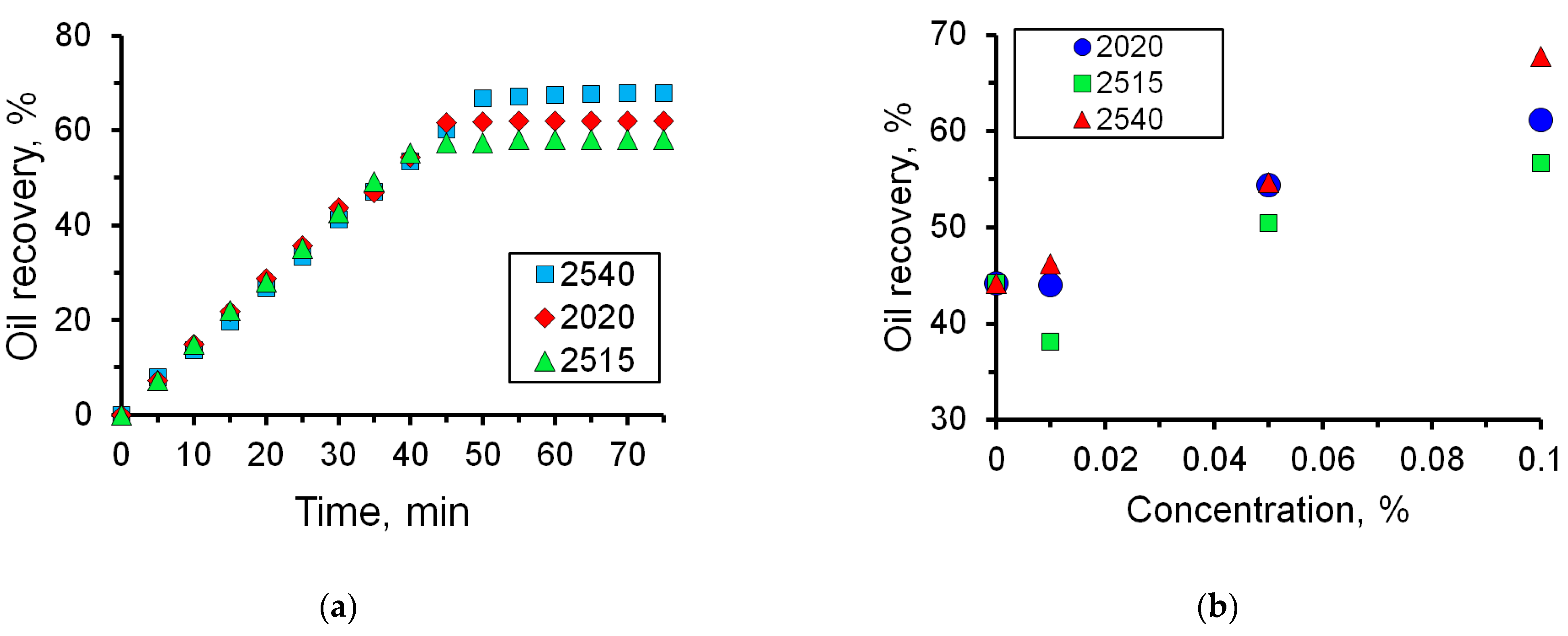
| Trademark | Molecular Weight, Million Units | Charge Density, % | Hydrolisys Degree, % | Bulk Density, kg/m3 | Manufacturer |
|---|---|---|---|---|---|
| Poliflok A2020 | 17–20 | 20 | 20 | 600–800 | NPO Polyflok |
| Praestol 2515 | 8–10 | 10 | - | 550–750 | CJSC Moscow-Stockhausen |
| Praestol 2540 | 12–14 | 30 | - | 600–750 | CJSC Moscow-Stockhausen |
| Optical Density D at Maximum Absorption Length λ, cm−1 | Spectral Coefficients | |||||||||
|---|---|---|---|---|---|---|---|---|---|---|
| 720 | 1030 | 1380 | 1465 | 1600 | 1710 | C1 | C2 | C3 | C4 | C5 |
| 0.119 | 0.048 | 0.445 | 0.846 | 0.05 | 0.011 | 0.420 | 0.013 | 0.053 | 11.30 | 0.057 |
| Chemical Element | Intensity, imp/s |
|---|---|
| Ca | 132 |
| S | 2484 |
| Displacement Fluid | Polymer Concentration, wt% | , deg | , mH/m |
|---|---|---|---|
| brine | - | 105.7 | 29.9 |
| polymer solution 2515 | 0.1 | 154.8 | 31.6 |
| polymer solution 2540 | 0.1 | 161.1 | 30.4 |
| polymer solution A2020 | 0.05 | 159.0 | 30.1 |
| polymer solution A2020 | 0.1 | 158.6 | 30.6 |
Disclaimer/Publisher’s Note: The statements, opinions and data contained in all publications are solely those of the individual author(s) and contributor(s) and not of MDPI and/or the editor(s). MDPI and/or the editor(s) disclaim responsibility for any injury to people or property resulting from any ideas, methods, instructions or products referred to in the content. |
© 2023 by the authors. Licensee MDPI, Basel, Switzerland. This article is an open access article distributed under the terms and conditions of the Creative Commons Attribution (CC BY) license (https://creativecommons.org/licenses/by/4.0/).
Share and Cite
Pryazhnikov, M.; Pryazhnikov, A.; Skorobogatova, A.; Minakov, A.; Ivleva, Y. Microfluidic Study of Enhanced Oil Recovery during Flooding with Polyacrylamide Polymer Solutions. Micromachines 2023, 14, 1137. https://doi.org/10.3390/mi14061137
Pryazhnikov M, Pryazhnikov A, Skorobogatova A, Minakov A, Ivleva Y. Microfluidic Study of Enhanced Oil Recovery during Flooding with Polyacrylamide Polymer Solutions. Micromachines. 2023; 14(6):1137. https://doi.org/10.3390/mi14061137
Chicago/Turabian StylePryazhnikov, Maxim, Andrey Pryazhnikov, Angelica Skorobogatova, Andrey Minakov, and Yulia Ivleva. 2023. "Microfluidic Study of Enhanced Oil Recovery during Flooding with Polyacrylamide Polymer Solutions" Micromachines 14, no. 6: 1137. https://doi.org/10.3390/mi14061137
APA StylePryazhnikov, M., Pryazhnikov, A., Skorobogatova, A., Minakov, A., & Ivleva, Y. (2023). Microfluidic Study of Enhanced Oil Recovery during Flooding with Polyacrylamide Polymer Solutions. Micromachines, 14(6), 1137. https://doi.org/10.3390/mi14061137






